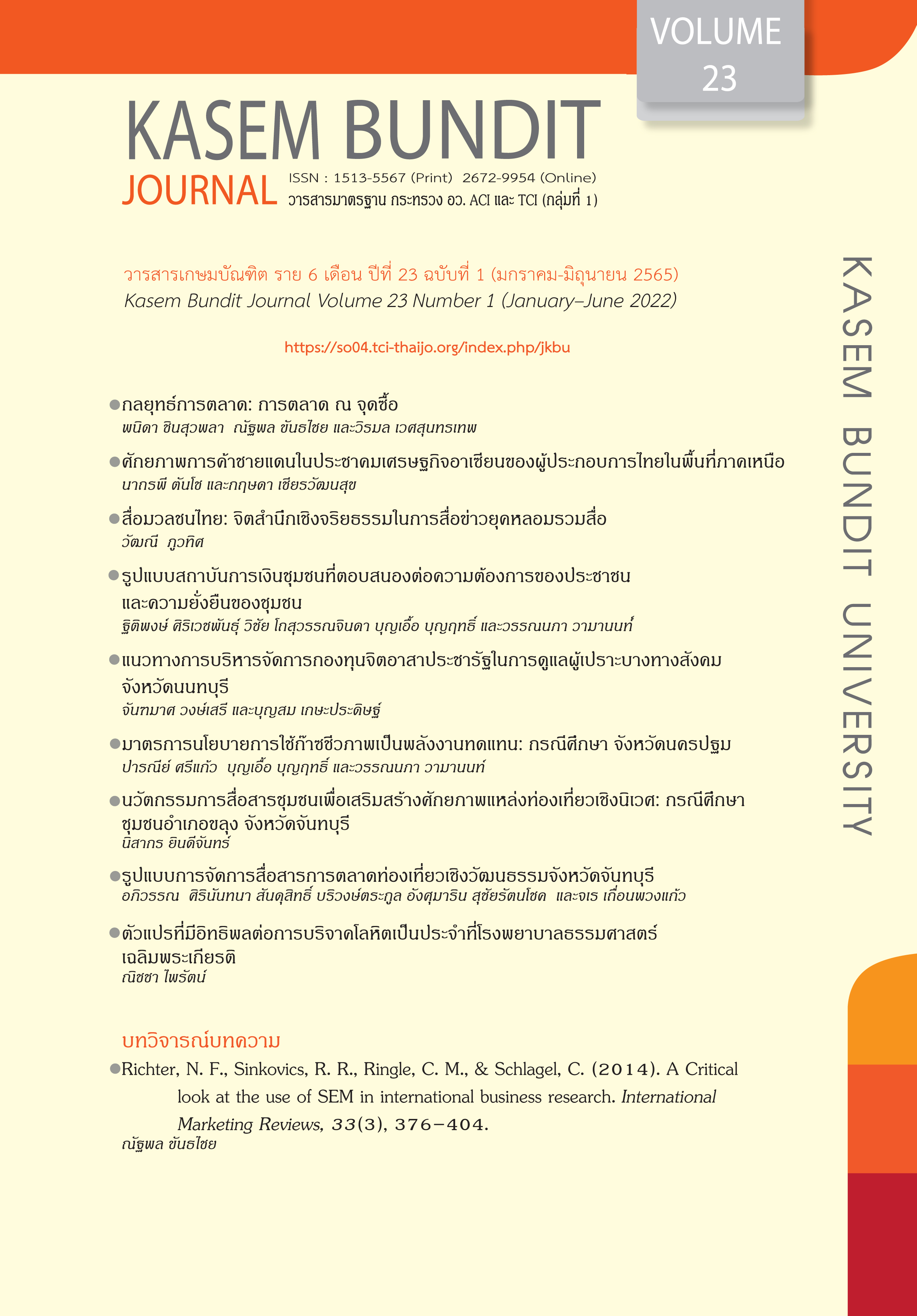Thai mass media: Ethical consciousness in news reporting in the era of mass media convergence
Keywords:
Ethical Consciousness, News Reporting, Era of Media Convergence, Thai MediaAbstract
PURPOSES: To investigate and compare the difference of the ethical consciousness between participants and non-participants in the professional training programs on news reporting in the era of mass media convergence. METHODS: Mixed methodology and the purposive multistage sampling method for the sample of 200 mass media people were adopted. The research instrument used in collecting the data was a questionnaire and an interview schedule to measure the ethical consciousness in news reporting in the mass media convergence era based on nine hypothetical situations. RESULTS: The professional training programs variables indirectly affected ethical consciousness in news reporting. Participants in the professional training programs had an ethical consciousness at a moderate level, while non-participants in professional training programs had an ethical consciousness at a low level. The ethical reasoning in news reporting in the mass media convergence era depended on the situation. THEORY/POLICY IMPLICATIONS: Mass media reporters are advised to report accurate facts to avoid misunderstanding. Even when news reporting goes wrong, reporters have to resolve problems immediately as it is a crucial responsibility of mass media. Data selection and data evaluation should be careful not to affect the rights of offender privacy and victims' families.
References
Blatt, M. M., & Kohlberg, L. (1975). The effect of classroom moral upon children’s level of moral judgment. Journal of Moral Education, 4(2), 129-161.
Bocrchert, D. M., & Stewart. (1986). Exploring ethics. Collier Macmillan.
Boonsomsuk, B., Boonsomchart, A., & Pikulparungroch, A. (2558). Ethical criteria of Thai media. Isara Media Review, 4(7), 7-22.
Chanthrawattanakul, S. D. (2555). Convergence journalism: Principles and concept. Double Click Press.
Cleary, J. (2006). From the classroom to newsroom: Professional development in broadcasting journalism. Journalism and Mass Communication Educator, 61(3), 254-266.
Gloor, P. A., Heckman, C., & Makedon, F. (2018). Ethical issues in collaborative innovation networks.
http://ccs.mit.edu/pgloor%20papers/COIN4Ethicomp.pdf.
Haidt, J. (2001). The emotional dog and its rational tail: A social intuitionist approach to moral judgment. Psychological Review, 108(4), 814-834.
Hassasiripoch, B. (2542). Consciousness. NIDA Faculty Senate Journal, 4(1), 71-73.
Hill, T. E. Jr. (2013). Virtue, rules and justice: Kantian aspirations. Philosophy in Review, 33(4), 298-300.
Iamsaard, L. (2561). Adaptation of regional media in the media convergence. http://ms.psru.ac.th/comm_integrat/admin/file/(Convergence).pdf
Immanuel, K. (2018). Immanuel Kant's fundamental principles of the metaphysic of morals.
https://study.com/academy /lesson/immanuel-kants-fundamental-principles-of-the-metaphysic-of-morals.html.
Kaewthep, K., & Chaikunpol, N. (2555). News media guide. Karnpim Limited Partnership.
Kohlberg, L., & Elfenbein, D. (1975). The development of moral judgment concerning capital punishment. American Journal of Orthopsychiatry, 45(4), 614-640.
Kolodzy, J. (2013). Practicing convergence journalism: An introduction to cross media storytelling. Routledge.
Kuntonbut, C. (2549). International Business Administration (9th ed.) Chulalongkorn University Press.
Lambeth, E. B. (1992). Committed journalism: An ethic for the profession (2nd ed.). Indiana University Press.
Logan, K. R. (2010). Understanding news media: Extending Marshall McLuhan. Peter Lang Publishing, Inc.
Makedon, A. (2009). Ethical perspectivism and practical perspectives in the classroom. Philosophical Study of Education, 2(1), 56-71.
McQuail, D. (2010). McQuail’s mass communication theory. (6th ed.). Sage Publications.
Pathak, R., & Imperiali, B. (1997). A dual affinity tag on the 64-k Da Nlt1p subunit allows the rapid characterization of mutant yeast oligosaccharyl transferase complexes. Arch Biochem Biophys, 338(1), 1-6.
Pavlik, J. (1999). Journalism and new media. Columbia.
Phuban, B. (2549). Alternative: An application of puppet playing video model to develop the second grade student’s public mind. [Unpublished master’s thesis]. Srinakharinwirot University.
Potter, R. B. (1965). The structure of certain American Christian responses to the nuclear dilemma, 1958-1963 [Unpublished doctoral dissertation]. Harvard University.
Ramaprasad, J., Lin, Y., & Garrison, B. (2012). Ethical use of new technologies: Where do Indian journalists stand? Asian Journal of Communication, 22(1), 98-114.
Rujithamrongkul, K. (2558). The influence of consciousness, moral, rightness and satisfaction of instructors and students at in business administration line. Academic Journal Bangkokthonburi University, 4(2), 70-90.
Terdthamkun, A. (2547). Nalistic awareness of professional ethics in Thai newspapers. [Unpublished master’s thesis]. Thammasat University.
The National Press Council of Thailand. (2560). Regulations on ethics of professional
newspapers.http://www.presscounsil.or.th/th2/content/view/4/8
Uwanno, B. (2015). The future Thai media after the new constitution.
http://www.presscouncil.or.th/highlight/
Yonelinas, A. P. (2001). Consciousness, control and confidence: The 3 CS of recognition memory. Journal of Experimental Psychology, 130(3), 360-379.
Yoon, S. (2555). The future of news. Se-ed Education Public Company Limited.
Downloads
Published
How to Cite
Issue
Section
License
Copyright (c) 2022 KASEM BUNDIT JOURNAL

This work is licensed under a Creative Commons Attribution-NonCommercial-NoDerivatives 4.0 International License.
ทัศนคติ ความคิดเห็นใด ๆ ที่ปรากฏในวารสารเกษมบัณฑิตฉบับนี้เป็นของผู้เขียน โดยเฉพาะ มหาวิทยาลัยเกษมบัณฑิตและบรรณาธิการ ไม่จำเป็นต้องมีความเห็นพ้องด้วย







